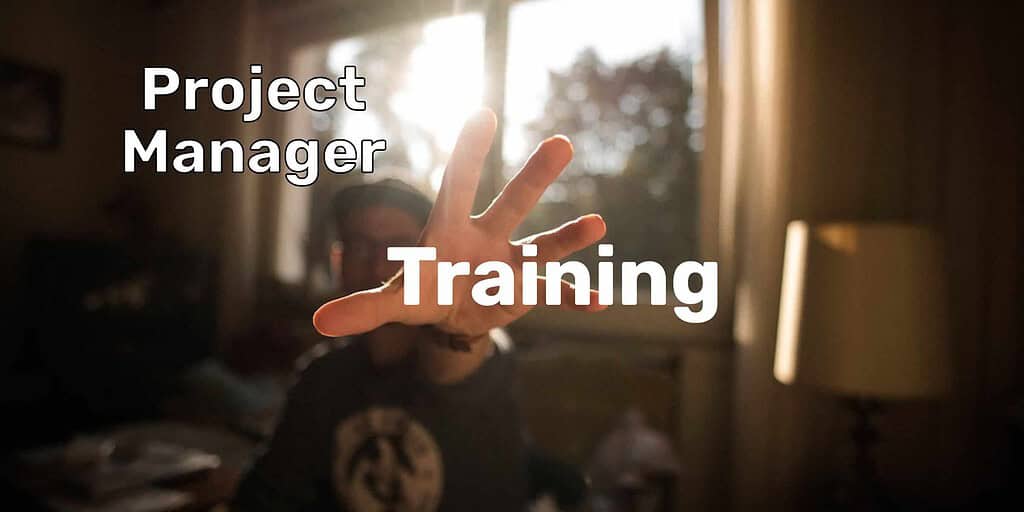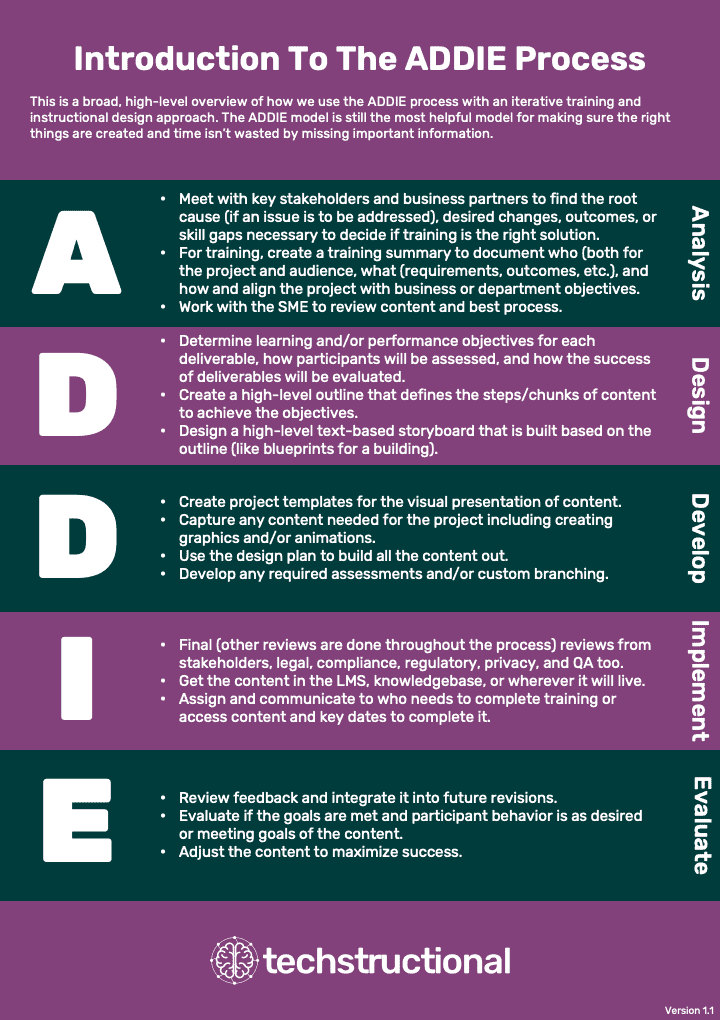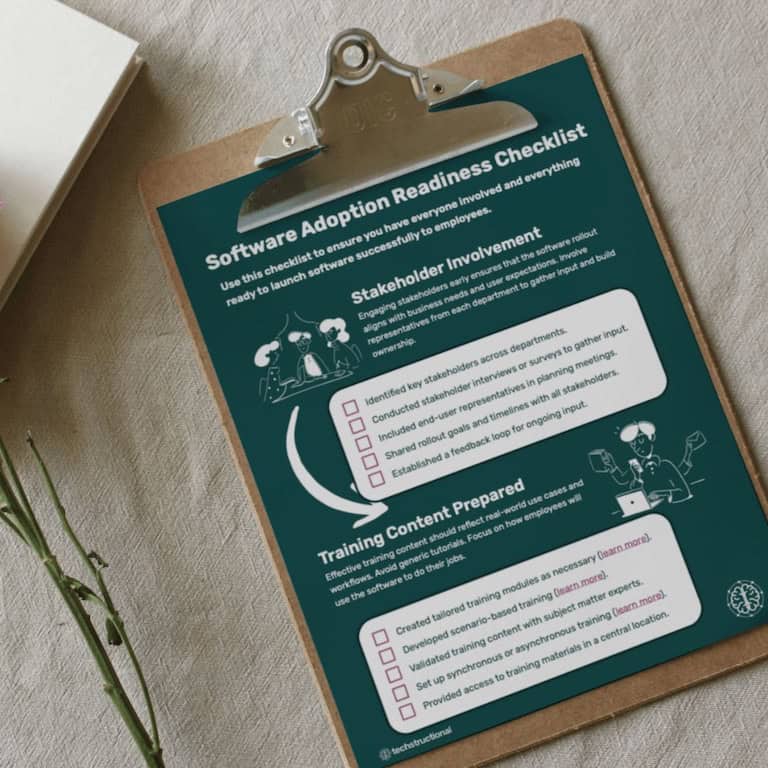Every project is unique, and the complexity of a project will determine how much time training professionals need for their process. As with all work, there’s more to creating training than just making it. There’s a lengthy analysis and design, a lot of back and forth, admin work, questions, review cycles, and more.
Needless to say, training is a complex machine like all other parts of a project. It takes time to develop good training, just as it takes time to develop and execute a good change and project management plan.
So, this post will attempt to answer the question of when you should bring training into the project to give them enough time to do a good job.

If you want to go straight to the answer with no details, here’s the TLDR:
Training should be brought in as soon as there’s some real progress on the project. At the bare minimum, that means 2-3 months before launching. Ideally, as soon as there’s something for the training department to look at, you’d bring them in.
So, as soon as the requirements are put together and development begins, bring in training. They may not be able to get to work right away, but they can start to put together a plan and help decide on the best approach.
Read on if you want to know why training needs so much time. There’s a lot more to good training than you might think. And yes, there’s also a big gap between training and good training. Anybody can throw some images in a PowerPoint and drone on for an hour. The problem is that it won’t be effective, will waste more time, and provide minimal to no results. That type of training would harm the project (and employees) more than help.
Training Type Will Determine the Time Needed
There’s likely a need for training in new projects, but a good training department won’t automatically assume training is the answer. That’s one reason why training should be brought in early. That will allow the ability to properly analyze a project, which is necessary to know the ideal type of training and if training is the best strategy.
When considering new technology and a new way of working for employees, a good assumption is that training is likely needed. The exact level of necessary training needs to be determined, but overall, training does help with change management for new projects.
There are many ways to classify training, but there is no easy way to do it. For example, there is synchronous (everybody’s in training simultaneously) and asynchronous (take the training whenever you want!) training. There’s also digital training, which could be both synchronous and asynchronous.
When looking at how far in advance training professionals should be brought in, it’s easiest to break training type into live and digital. That’s because live training can have a lot of overhead that doesn’t exist in the digital world.
Let’s examine live training first because it will require a lot more effort to execute than digital training. That’s one reason digital is so popular now: There’s less overhead, and it makes more sense with a distributed workforce.
Live Training
Live training varies greatly for how long it takes to prepare, create, and execute. That’s because live training methods vary a lot. It could be an hour-long training session with a small group in a conference room or a multiple-day event where most people have to fly in and stay in hotels and anything in between.
For projects, the long multi-day events are likely not necessary. So, when training should be brought in, I’ll assume it’s an on-location training session that lasts an hour to a day.
There’s still a lot of preparation to do, though. The content to be trained must be planned, designed, and developed. That could mean having all the materials necessary to plan a schedule that works.
1-2 months MINIMUM should be allotted to prepare for live training.
Live training isn’t always the best option, given that everybody has to be pulled away from their jobs, but that’s beside the point. Training should still be brought in well before employees need it.
When live training is planned, the training department should ideally be brought into the project 2-4 months before training begins. What needs to be trained will vary greatly, so keep that in mind.
It’s always best to consult with training professionals to ensure enough time is allotted. It never hurts to meet at the beginning of the project so they can begin planning if they have the capacity. You never know; you could bring them into the project, but their schedule doesn’t allow them to start for three months.
Meet with training at the beginning of the project or at the latest when there’s something for them to look at. That could be as simple as the requirements documents for initial conversations to get it on their project list.
Because training is never as simple as it seems, it’s always best to consult your training department as early as possible. That will ensure fewer time and resource constraints for training employees.
Digital Training
Digital training solutions are generally a bit more predictable regarding development time. While there are many variables to account for, there aren’t as many things that could go wrong as in live training. There are fewer expenses and moving parts.
Part of the beauty of digital training solutions is that there’s no traveling, bookings, catering, or anything like that. It’s as simple as a computer and the time to account for after development.
Many variables come in before development.
When you should involve training depends entirely on what needs to be trained. If it’s a simple single task that people need to do, you could get away with bringing in training a month before launch.
The MINIMUM time needed to ramp up digital training solutions is 1-2 months.
But, for most training, 1-2 months is the minimum for a simple project if it involves at least one course and other content. When I say simple, I mean a project that requires a job aid or two and perhaps one short course.
As with live training, it’s best to bring training folks in as soon as possible. That means beginning the conversations when the project starts.
If you want to ensure ample time to do the best job possible for digital training content, including performance support, 2-4 months is even better. Most courses take about four months due to shifting priorities, delays, and unique risks in every project.
The training process can take three months if everything goes smoothly, with quick reviews and minimal changes. Every project is unique, so it’s best to talk about training as early as possible.
The Ideal Time to Bring Training into A Project
This isn’t how long it takes to create content. That will depend entirely on the level of interactivity and many other factors. Because there is a lot of review time and time when a project can be held up, the actual development time varies greatly from when you should bring training into a project.
If a simple course takes 80 hours to develop, you can’t bring in training two weeks before training is needed and expect it to be done on time. For one, there’s more to creating training than development. The majority of the tasks happen before development even begins.
Then, there are many review cycles between each step, changes need to be made, and I’m sure you’ve never heard of someone working 8 hours every day solid on only training, with no time for questions and all the other admin tasks that go along with a project. Just reviews alone can sometimes take weeks.
Nobody is a robot, including instructional designers.
That’s why you should bring training in as early as possible. That might vary for each project, but that should be no later than three months before the planned launch, ideally more. While 1-2 months is a minimum, sacrifices and crunch time would be required.
You will be better off bringing training into the mix once the project is approved and scoped (don’t forget to scope in training!) and requirements are set. When there’s something in cement for the training people to look at, that’s when you need to bring them in.
When someone comes to us with a project deadline a month away, the training options will be limited. You can only throw so many people at a project to make it go faster before it turns into a mess with poor results (we’ve seen it happen too often). If you come to us with a new technology launch in four months, that should be enough time to assemble a good training plan to cover the needs of employees and the project.
If you come to us with a new IT system launching in 4 months, that should be enough time for most digital training solutions to be created.
If it’s an in-person large event, then it could require longer. We don’t manage those types of projects, so we can’t speak to the exact timing needs. We don’t do any type of instructor-led training at all. But I’m sure they could take as long as six months to a year to plan and execute well properly.
A lot happens between bringing the training department into a project and when employees take it. I’ll give you a quick run-through of that process so you can see the inner workings of training and why so much time is needed.
What Happens in That Time
A lot happens when you come to us for a new training solution. Before we present training solutions to you, our training design process begins with analysis—even before training is decided upon. For that, we meet with you to learn about the project, requirements, performance goals, and any content you may have.
Before any training development happens, a proper analysis will help decide if training is the right answer. If training is a good solution, then our analysis proceeds to determine the ideal solution. That could mean custom eLearning development, multiple courses, job aid(s), quick reference guide(s), or something else entirely. Each project is unique.
Depending on the project’s complexity, this can take a week or possibly even two. Once training design and development begin, that process takes time, too.
We go through a process known as ADDIE (ADDIE still reigns supreme in the training world). In its modern form, ADDIE is an iterative process for creating training, and you could even work with it in an agile way. At its core, ADDIE stands for Analyze, Design, Develop, Implement, and Evaluate.
- Analyze: We review the content and make sense of everything to see the big performance goals that need to be trained on. This takes 1-2 weeks.
- Design: The bulk of the process happens here. With digital training, most of this process happens in steps to put content together at a high level, group it together (chunking), write the learning objectives, outline the content, storyboarding, etc. It’s essentially the blueprint for all the training content. This process takes 2-4 weeks minimum.
- Develop: The blueprints are now turned into the final product using whatever tool is needed. This is where everything comes to life with recorded audio and images, and making it all come together for the first draft so you can almost see the final product. This typically takes 2-4 weeks.
- Implement: This is where the rubber meets the road. That means you could either begin training the trainer or, in the case of eLearning, load and assign the content to a learning management system (LMS) or a website if the organization has no LMS. Depending on your requirements, this could take less than a week or more than two weeks.
- Evaluate: Did the project meet the goals? Are surveys telling us something needs to be changed? This is where we look back at the process and how it all came together. While each step of the process is done in iterations, this could be a big one. If things need to be changed, then that might need to happen to make training a success. There is no specific amount of time this step takes. You may collect feedback and data and decide if a revision is necessary six months to a year after training is launched.
Between all of that, many other steps take time and have their own risks. There are typically about 3-4 sessions for SME and business partner reviews sprinkled throughout the process. Those can take time, especially if many reviews are needed or reviewers are busy.

I’ve seen projects take twice as long as the initial estimates simply because the reviewers were busy and took a month to do their job. Having content reviewed by legal, compliance, privacy, risk, or others can add additional time. That could easily add at least two weeks or more to the process.
Remember QA (quality assurance)! All the content developed needs to be reviewed for grammar and functionality as well. As you can see, a lot happens between initial training conversations and when employees see content.
With everything that happens during the process, many risks could make it take longer. That’s not even mentioning the risks baked into the project itself. Software development can go over schedule easily and change the entire timeline.
Training Risks
As with all project steps, training also has potential risks. Many potential risks are nearly impossible to account for, including technical issues, slow review processes, regulatory concerns, and more.
One of the most common risks in a project is business partners or subject matter experts who become too busy to review. If the training side of things gets stuck at a review stage, that can throw the whole timeline off. Training could be delayed a month or more simply because training products aren’t being reviewed in time.
So, a two-month project could easily turn into a four-month or more project without proper risk mitigations. Mitigating this risk could be as simple as having a main content reviewer and a backup reviewer.
This is a list of some common risks that can delay the training portion of a project.
- Subject matter experts (SME) not being available.
- Reviews taking longer than anticipated with more changes or complete rewrites necessary.
- Software not ready for instructional designers to view to start designing.
- Delays in the actual system launch date.
- Legal, compliance, privacy, risk, or other regulatory concerns or delays.
There are often ways to mitigate these risks, but not all can be avoided. We often do the best we can while planning for issues. With a good plan in place, training can meet any deadline and be available to help employees better adjust to their changing environment.
Wrap Up
Now you know when to bring in training professionals. Whether you’re a project manager or change manager who foresees the need for training, knowing when to bring in training professionals is half the battle.
Just as it’s best to bring change management into a project early, it’s also best to bring in training around the same time. Not every project gets a change manager at the ideal time, which also doesn’t always happen with training.
It’s okay if training isn’t always brought in early on as the project starts. But it’s best to bring training in as early as possible and no later than two months before launch. The expectation should be that training will be limited when they have less than two months to create it. It might come down to a handful of job aids instead of an interactive course that requires several months to build.
The earlier you bring in training, the more successful training will be.
If you want the most effective training solution, schedule training four to six months before employees need it. That will allow plenty of time to develop and execute a great training plan.
Giving plenty of time for training professionals to work their magic also means risks are easier to mitigate. A slow review process can have a much larger buffer if there’s plenty of time for reviewers to take the time they need.
The type of training required will also affect the time needed. So, while it’s a good idea to bring training in early to plan the right solution, they won’t necessarily need to work on training the entire time. Bringing training in early allows for the best results.
Bring training into a project early to start having those conversations about the project and the best solution. We’d love to discuss your next corporate technical project and how we can help you with training, schedule a free consultation. Just give us enough time to work the best training magic possible.
